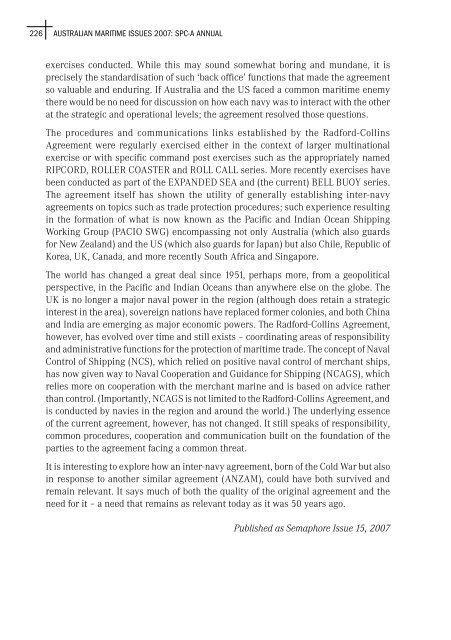Australian Maritime Issues 2007 - Royal Australian Navy
Australian Maritime Issues 2007 - Royal Australian Navy
Australian Maritime Issues 2007 - Royal Australian Navy
You also want an ePaper? Increase the reach of your titles
YUMPU automatically turns print PDFs into web optimized ePapers that Google loves.
226 AUSTRALIAN MARITIME ISSUES <strong>2007</strong>: SPC-A ANNUAL<br />
exercises conducted. While this may sound somewhat boring and mundane, it is<br />
precisely the standardisation of such ‘back office’ functions that made the agreement<br />
so valuable and enduring. If Australia and the US faced a common maritime enemy<br />
there would be no need for discussion on how each navy was to interact with the other<br />
at the strategic and operational levels; the agreement resolved those questions.<br />
The procedures and communications links established by the Radford-Collins<br />
Agreement were regularly exercised either in the context of larger multinational<br />
exercise or with specific command post exercises such as the appropriately named<br />
RIPCORD, ROLLER COASTER and ROLL CALL series. More recently exercises have<br />
been conducted as part of the EXPANDED SEA and (the current) BELL BUOY series.<br />
The agreement itself has shown the utility of generally establishing inter-navy<br />
agreements on topics such as trade protection procedures; such experience resulting<br />
in the formation of what is now known as the Pacific and Indian Ocean Shipping<br />
Working Group (PACIO SWG) encompassing not only Australia (which also guards<br />
for New Zealand) and the US (which also guards for Japan) but also Chile, Republic of<br />
Korea, UK, Canada, and more recently South Africa and Singapore.<br />
The world has changed a great deal since 1951, perhaps more, from a geopolitical<br />
perspective, in the Pacific and Indian Oceans than anywhere else on the globe. The<br />
UK is no longer a major naval power in the region (although does retain a strategic<br />
interest in the area), sovereign nations have replaced former colonies, and both China<br />
and India are emerging as major economic powers. The Radford-Collins Agreement,<br />
however, has evolved over time and still exists – coordinating areas of responsibility<br />
and administrative functions for the protection of maritime trade. The concept of Naval<br />
Control of Shipping (NCS), which relied on positive naval control of merchant ships,<br />
has now given way to Naval Cooperation and Guidance for Shipping (NCAGS), which<br />
relies more on cooperation with the merchant marine and is based on advice rather<br />
than control. (Importantly, NCAGS is not limited to the Radford-Collins Agreement, and<br />
is conducted by navies in the region and around the world.) The underlying essence<br />
of the current agreement, however, has not changed. It still speaks of responsibility,<br />
common procedures, cooperation and communication built on the foundation of the<br />
parties to the agreement facing a common threat.<br />
It is interesting to explore how an inter-navy agreement, born of the Cold War but also<br />
in response to another similar agreement (ANZAM), could have both survived and<br />
remain relevant. It says much of both the quality of the original agreement and the<br />
need for it – a need that remains as relevant today as it was 50 years ago.<br />
Published as Semaphore Issue 15, <strong>2007</strong>
















